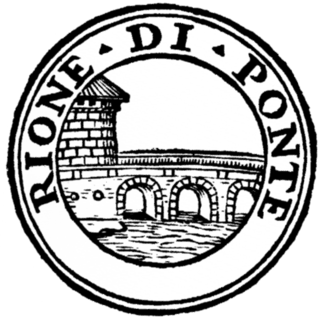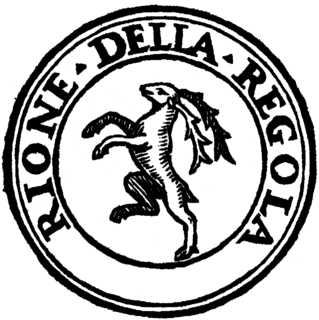The Prior of the Caporioni (Italian - Priore dei Caporioni; Latin - cap. reg. urbis priore) was the caporione or capo rione of rione I of late medieval Rome.

A rione of Rome is a traditional administrative division of the city of Rome. "Rione" is an Italian term used since the 14th century to name a district of a town. The term was born in Rome, originating from the administrative divisions of the city. The word comes from the Latin word regio ; during the Middle Ages the Latin word became rejones, from which rione comes. Currently, all the rioni are located in Municipio I of Rome.

Rome is the capital city and a special comune of Italy. Rome also serves as the capital of the Lazio region. With 2,872,800 residents in 1,285 km2 (496.1 sq mi), it is also the country's most populated comune. It is the fourth most populous city in the European Union by population within city limits. It is the centre of the Metropolitan City of Rome, which has a population of 4,355,725 residents, thus making it the most populous metropolitan city in Italy. Rome is located in the central-western portion of the Italian Peninsula, within Lazio (Latium), along the shores of the Tiber. The Vatican City is an independent country inside the city boundaries of Rome, the only existing example of a country within a city: for this reason Rome has been often defined as capital of two states.
Each of Rome's rioni was led by a caporione, who was supported in his public-order duties by other local citizens on oath known as constables (constabili or capotori). [1] However, the caporione of Rione I was also ex officio a subordinate magistrate under the Conservatori of Rome. Unlike the other caporioni, he also usually came from the Roman urban nobility (patriziato romano). All the other caporioni were abolished in the mid 18th century, but the post of Prior of the Caporioni was only abolished during the reforms of pope Pius IX via a special motu proprio law entitled Structure and municipal organisation and administrative organisation of the city (Struttura e organizzazione municipale e dell'amministrazione degli uffici) dated 1 October 1847.

Pope Pius IX, born Giovanni Maria Mastai-Ferretti, was head of the Catholic Church from 16 June 1846 to his death on 7 February 1878. He was the longest-reigning elected pope in the history of the Catholic Church, serving for over 31 years. During his pontificate, Pius IX convened the First Vatican Council (1869–70), which decreed papal infallibility, but the council was cut short owing to the loss of the Papal States.
In law, motu proprio describes an official act taken without a formal request from another party. Some jurisdictions use the term sua sponte for the same concept.
















